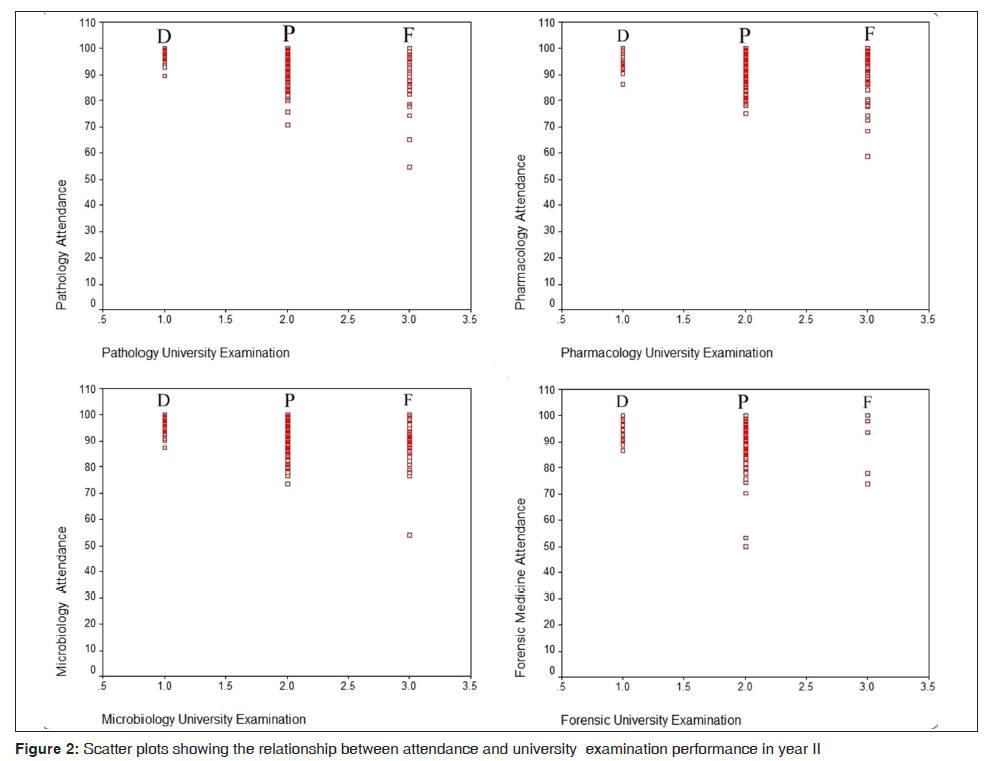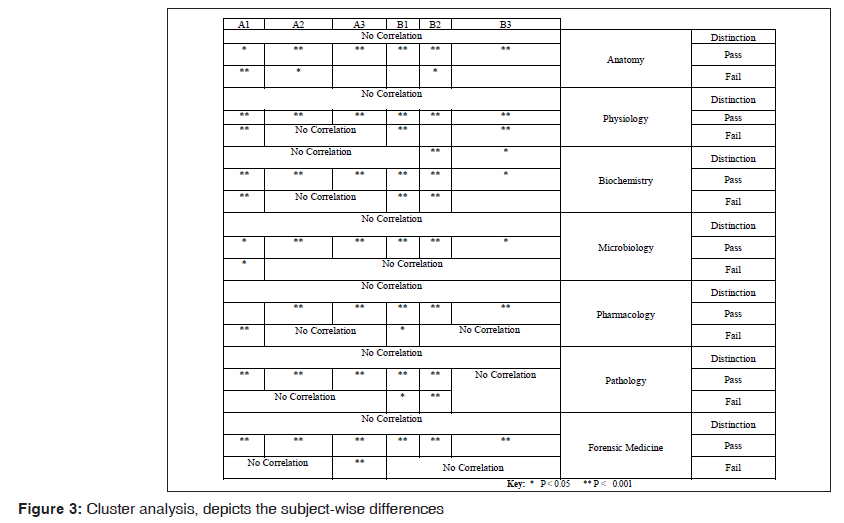Attendance and Achievement in Medicine: Investigating the Impact of Attendance Policies on Academic Performance of Medical Students
- *Corresponding Author:
- Dr. Barathi S. Subramaniam
Melaka Manipal Medical College, Manipal Campus, ICHS, Manipal University, Manipal, Karnataka, India
E-mail: barathi2021@gmail.com
Citation: Subramaniam BS, Hande S, Komattil R.Attendance and achievement in medicine: Investigating the impact of attendance policies on academic performance of medical students. Ann Med Health Sci Res 2013;3:202-5.
Abstract
Background: The attendance mandate for the medical course in Melaka Manipal Medical College, Manipal, India was increased from 75% to 90% based on the assumption that the mandatory increase will improve the students’ performance. Aims: To find out whether there is any correlation between class attendance and academic performance. Subjects and Methods: This was an institution based retrospective analytical study. Students who have completed Phase I (first two and a half years) of the MBBS course were included in the study. Student marks and attendance, from the database were obtained from three random batches, each, from two clusters A and B respectively. Those who had a mandatory attendance requirement of 75% belonged to A (n = 243), and those who had a mandatory attendance percentage of 90% belonged to B (n = 360). Statistical analyses performed included, Pearson 2 tailed correlation to correlate class attendance with student performance; Cluster analysis to classify group average in a similarity matrix; t-test to determine significance of difference in percentage of students who attained 100% when the college changed mandatory attendance from 75% to 90%; Mann–Whitney test to find out if there was a better performance in university exam when attendance policy changed. Results: There was a significant correlation between attendance and the students who passed in the University exam. The number of students in the pass category was maximum (>90%) compared to students in distinction and failed categories. Percentage of students with 100% attendance rose from 4% (n = 10) to 11% (n = 40) when the mandatory attendance was increased from 75% to 90%. Conclusions: Attendance policy correlated with better academic performance. Reducing absenteeism, probably contributed to the improved academic performance of the students. But the link between attendance and best and worst performances could not be predicted because of small numbers in every batch.
Keywords
Attendance, academic performance, assessment
Introduction
Class attendance still remains a key determinant of academic performance. Research on class attendance has established that, on average, students with high attendance achieve higher academic performance in both coursework and examinations than students with poor attendance.[1?5] Attendance policy has a strong impact on reducing absenteeism; the link between absenteeism and exam performance is weak.[6?8]
Traditionally lectures and tutorials have been the dominant forms of instruction in conventional face?to?face undergraduate courses. The primary mode of curriculum delivery at Melaka Manipal Medical College (MMMC), Manipal Campus, is full?time, contact lectures, supported by self?directed learning (SDL), and problem based learning (PBL). This mode of delivery implies that students regularly attend face?to?face activities.
The academic year for the undergraduate medical course is divided into four blocks of 10 weeks each. The students are assessed in the last week of each block. University examination is conducted at the end of the course (two weeks after the IV block examinations).
When the program commenced in 1997, the attendance mandate was 75%, but students were encouraged to attend 100% of the classes. If a student attended 90% or more classes, they were allowed to drop, a least scoring block out of the four blocks, while taking into account the internal assessment. But accreditation bodies objected to the dropping of the block, and their justification was that students maintain attendance but may miss out on important academic material if they know that they would be dropping a block. Therefore, to enhance the standard of the programme and to improve commitment of the students, the attendance mandate was increased from 75% to 90% based on the assumption that the mandatory increase from 75% to 90% will improve their performance.[9]
It is rather difficult to know directly how much learning actually happens when students are physically present in the class, especially during lectures. So a retrospective study was undertaken in order to indirectly explore a relationship, if any between attendance and attainment.
Studies on attendance rates and academic performance of medical students in India are very few.
This study aims to assess if the increase in mandatory attendance percentage had an impact on academic performance of students in a medical school.
Subjects and Methods
All the students from six batches (n = 603) who have completed Phase I (first two and a half years) of the MBBS course at Melaka Manipal Medical College, Manipal Campus (MMMC), India were included in the study.
The students belonged to three random batches, each, from two clusters A and B respectively. Those who had a mandatory attendance requirement of 75% belonged to A (n = 243), and those who had a mandatory attendance percentage of 90% belonged to B (n = 360). Attendance, internal assessment and university grades of all the students were obtained from the student data base, records and documents of university results of all the seven subjects the students learnt.
The data obtained was entered into excel and using SPSS version 16.0 the statistical parameters were analyzed. Statistical analyses performed included, Pearson 2 tailed correlation to correlate class attendance with student performance; cluster analysis to classify group average in a similarity matrix; t?test to determine significance of difference in percentage of students who attained 100% when the college changed mandatory attendance from 75% to 90%; Mann–Whitney test to find out if there was a better performance in university exam when attendance policy changed.
Ethical approval was obtained from the Institutional Research and Ethics Committee of MMMC.
Results
Internal assessment and university exam results in all seven subjects [Figures 1?3], correlated. P = 0.01 in anatomy, P = 0.01 in physiology and biochemistry. In pathology (P = 0.05), microbiology (P = 0.04), pharmacology (P = 0.01) and forensic medicine (P = 0.02).
Percentage of students with 100% attendance rose from 4% (n = 10) to11% (n = 40) when the mandatory attendance was increased from 75% to 90%. All batches of students of both the clusters showed significant correlation between attendance and meeting the minimum requirement of 50% in the university examination. In every batch, the number of students in pass category was maximum (>90%) compared to students in distinction and failed categories. Distinction and unsuccessful students did not always show a correlation with attendance.
Discussion
The study examined the relationship between attendance percentage and examination performance. It also analyzed the impact of an enforced attendance policy of 90% and compared the examination performance of students group which had 75% attendance.
This study is consistent with the findings and observations of earlier studies with regard to the number of students passing the exam; every batch, every exam, from all the study groups. It reflects strong relationship with student performance.
The finding of this study reveals that the implementation of an attendance policy improves exam performance. There is an increase by 7% which roughly is close to the findings illustrated in a recent study.[10]
Marburger observed a fall in attendance from 85% to about 76%,[6] when mandatory attendance policy was removed whereas our study observed an increase when a mandatory policy was implemented. This positive response could be due to motivation and positive reinforcement.[11] This finding also corroborates White’s assertion that policies that require and/or reward attendance result in greater attendance.[12]
Distinction and unsuccessful students did not always show a correlation with attendance. This could be because in every cohort, the number of students in distinction and failed categories was low.
Attendance policy correlated with better academic performance. Reducing absenteeism, probably contributed to the improved academic performance of the students. Whether it is because of incentivizing attendance or inculcating a sense of commitment that has led to better attendance and better performance is yet to be explored. Further empirical investigations should be undertaken to identify whether this is the case across disciplines, universities and countries. Class attendance was investigated only for first two years and not entire undergraduate program. The study is being expanded to take account of these limitations.
Acknowledgements
Dean, Melaka Manipal Medical College, (Manipal Campus), India.
Dr Asha Kamath, Selection Grade Lecturer (Biostastics), Kasturba Medical College, Manipal, Karnataka, India. Office staff, Melaka Manipal Medical College, (Manipal Campus), India.
Source of Support: Nil.
Conflict of Interest: None declared.
References
- Romer D. Do students go to class? Should they? J Econ Perspect 1993;7:167-74.
- Von Blerkon ML. Class attendance in undergraduate course. J Psychol 1992;123:487-94.
- Gunn KP. A Correlation between attendance and grades in a first year psychology class. Can Psychol 1993;34:202.
- Park KH; Kerr PM. A determinant of academic performance: A multinomial logit approach. J Econ Educ 1990;21:101-11.
- Nyamapfene A. Does class attendance still matter? Engg Educ 2010;5:1-9.
- Marburger DR. Does mandatory attendance improve student performance? J Econ Educ 2007;37:148-55.
- Burd E, Hodgson B. Attendance and attainment: A five year study. ITALICS. 2006;5:12pages. Available from: http://www.ics.heacademy.ac.uk/italics/vol5iss2/burd-att-italics-06-final.doc. [Last cited on 2006 May].
- Melaka Manipal Medical College, Student Brochure, Manipal University, Manipal; 2007.
- Sharma M, Mendez A, O?Byrne J. The relationship between attendance in student cantered physics tutorials and performance in university examinations. Int J Sci Educ 2005;27:1375-89.
- Allen DO, Webber DJ. Attendance and exam performance at university: A case study. Res Post-Compulsory Educ 2010;15:33-47.
- Devadoss S, Foltz J. Evaluation of factors influencing student class attendance and performance. Am J Agric Econ 1996;78:499-507.
- White FC. Enhancing class attendance. NACTA J 1992;36:13-5.







 The Annals of Medical and Health Sciences Research is a monthly multidisciplinary medical journal.
The Annals of Medical and Health Sciences Research is a monthly multidisciplinary medical journal.